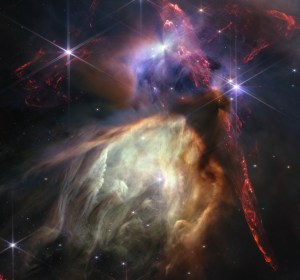Todd J. Barber, Cassini lead propulsion engineer
Occasionally this column has focused on science or engineering teams on the Cassini project. Once in a rare while, it might even highlight a Cassini team member. However, after nearly three years of penning this column, I thought it was high time you meet the Cassini Program Manager, Bob Mitchell, my ultimate boss on Cassini. Bob has been at the helm since June 1998, guiding Cassini and (virtually) its team by Venus, Earth, and Jupiter on a multi-billion-mile journey to Saturn. Even though I’ve worked with Bob nearly my entire two decades at the Jet Propulsion Laboratory (JPL), it was nice to learn more about the man behind the vaunted title.
Bob started at JPL in November of 1965, about six months before I was born! Originally from Springville, Pennsylvania, he took a sojourn west to obtain a B.S. in electrical engineering at the University of Arkansas in Fayetteville. A lifelong interest in mathematics couldn’t be denied, so Bob stayed on to garner an M.S. degree in math, focused more on applied mathematics. Apparently a glutton for academic punishment, he then obtained another M.S. degree, once again in electrical engineering, since he wasn’t sure about pursuing a career in mathematics. His M.S. work in control systems combined his interests well, and then he began a one-year stint as a weapons systems analyst for a defense contractor near Dallas, TX. Work was tight around this time for contractors, so Bob answered an ad in “Aviation Week” placed by JPL. Recall that during this time the first missions to the moon, JPL’s Rangers, were just making headlines, for the first lunar soft-landers, the Surveyors, were still a year off. Enamored with the appeal of space exploration, Bob began his 45-year (and counting) career at JPL.
In four and half decades at the lab, Bob has largely focused on navigation and mission design—again, positions which align well with his interests and education. Starting with the Mariner and Viking missions of the 1960’s and 1970’s, he worked as a section manager, mission design manager, and a maneuver and trajectory lead. Through the 1980’s, Bob was the Galileo Mission Design Manager, helping steer this beleaguered spacecraft through no less than five flyable redesigns. He also started doing some navigation work for Galileo as launch approached, but then migrated to line management as the Mission Design Section Manager from 1988 through 1993. At this time, the Galileo Science and Mission Design Manager, Jim Dunn, passed away. Galileo Project Manager Bill O’Neil called Bob to offer him Jim Dunn’s job. Bob originally declined, but Bill was persistent and convinced him, over lunch at a Mexican restaurant. This was the position Bob held when I first met him, since my first stint at JPL was on Galileo as a propulsion engineer, from 1990-1997. Little did I know that one day I would report to him, working on a Saturn orbiter named Cassini!
I asked Bob about his biggest challenge during his years as Cassini project manager to date, and he mentioned something near and dear to my heart. Preparing for Saturn Orbit Insertion (SOI) was extremely challenging, especially given how much development work was “thrown over the fence” into mission operations — while flying! He mentioned all the reviews we supported and how overworked and underfunded we were, which I remember all too well. After SOI and the wonderful initial results at Saturn, though (including Huygens), our funding has been stable, and the number of reviews has decreased — but we’re still overworked (oh, well, two out three ain’t bad). The type of cutting-edge, unique science that Cassini delivers day after day is worth putting in some extra effort.
Naturally, I was also curious about Bob’s take on the Solstice Mission, our second mission extension which may take us through 2017. He said his biggest challenge was to do everything we’ve proposed to NASA Headquarters with basically 60 percent funding levels for non-science activities vs. the funding levels for the prime and extended missions. Through this, he has every confidence that our science results will continue as we focus on difficult questions raised during the mission to date, such as, “What are the properties of Titan’s atmosphere?” and “What is happening in the interiors of Enceladus and Titan?” and perhaps most notably, “What changes will the new Saturn season bring throughout the Saturnian system?”
We closed our time together discussing Bob’s life outside of work. I knew he was involved with restoring old motorcycles, but I didn’t know his prowess in this area. He doesn’t ride as much as he did in decades past, but one of his favorite activities is restoring old “project” bikes, all the way from motorcycles that don’t run to those with missing pieces to those IN pieces and “in boxes.” He has sold a few of his creations, but generally he keeps them, rides a few now and then, and competes in shows with them. It was fun seeing some magazine articles with a picture of his beautiful 1940 Indian Four, a “Best in Show” winner, no less! Clearly this project manager can do more than fly spacecraft, though, like me, he opined that JPL is a great place to work and he “never considered going anyplace else” once here. Bob, I share your sentiment, and it was nice taking a small break from our wonderful spacecraft to learn more about you. Thank you.































